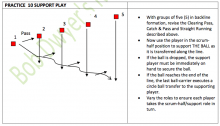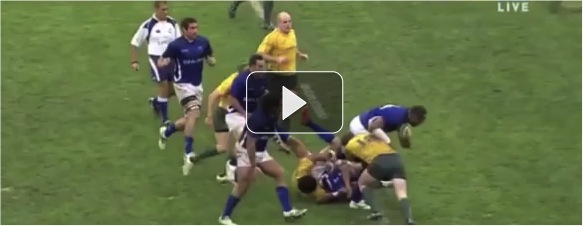Samoa played well against Australia on Sunday.
This was not simply a team of wonderfully gifted athletes coming out on top of an underperforming rugby team. This was the performance of a squad who have a clear understanding of the fundamentals of the game and who execute under pressure with quality technique.
From now on, each week we will identify a segment of a game — something special — and analyse from video the specific techniques on display, with illustration and reference to my Coaching Manual.
Soon after half-time in Sunday’s Test, Samoan lock Kane Thompson scored a wonderful team try from counter-attack after a Wallaby clearing kick. Here’s how it came about:
At the 45-minute mark, the Wallabies attempt to clear their quarter with the ball in hand. They make no headway after four phases, then Matt Giteau kicks. It is a long, low, driving kick that sends Samoan fullback Paul Williams back to near his quarter-line to retrieve the ball.
The Wallaby kick-chase is poor – despite this being only five minutes after the break – and Williams is able to carry the ball back beyond the half-way line. In fact the only acceptable chase comes from Giteau himself. I have calculated that Williams had to turn twice and covered a total of 47 metres, while the Wallaby chasers covered only 45 metres, with no turns!
[youtube]http://www.youtube.com/watch?v=9tPsgeqywgs[/youtube]
Let’s now analyse the positive aspects of the Samoan play:
- Chase back by Samoa — the aim in counter-attack is to get enough players quickly back behind the ball to present a number of possibilities for attack.
- By the time Williams is tackled on the Wallaby side of half-way, Samoa have at least eight players back behind him – numbers 2, 12, 9, 10, 7, 14, 8 and 4. Interestingly, 2 (Schwalger), 4 (Thompson) and 7 (Fa’asavalu) were involved in the attempted charge-down of Giteau’s clearing kick. (The chase back is purely and simply a state of mind – you just have to work on it. Samoa have clearly worked on it and got their just reward.)
- Schwalger alone cleans out the feeble Wallaby pressure at the tackle for an immediate recycle for Fotuali’i (9) to clear to the attack, which has realigned with urgency. (These actions must be completed without hesitation. We must not have a stop-start attack. Players must run backwards with urgency to take advantage of the quickest possible recycle.)
- Fotuali’i clears immediately to Tusi Pisi (10), who is beautifully positioned. He runs wide looking for space and his realigned support players, but executes a dummy switch with Fa’asavalu to ask questions of the defence. (Successful attack is about asking questions of the defence. Fa’asavalu was vital in posing such a question, even though he didn’t touch the ball.)
- This manoeuvre allows Pisi to make a half-break and he fights to stay on his feet. (Our intention should be always be to stay on our feet and continue our drive forward – and thereby attract as many defenders as possible. Pisi attracts four!)
- In support play, players should stay on hand but with enough width and depth to allow them to stay with the ball-carrier as he changes his line or pace. Fa’asavalu, Fotuali’i, Thompson and Tagicakibau (14) are beautifully positioned with depth to take advantage of Pisi’s desire to continue play. He off-loads to Tagicakibau, who off-loads to Fa’asavalu, who then off-loads to Stowers (8). Stowers has earlier changed his wider line to arrive closer and with depth, as he observes Pisi’s half-break. Fotuali’i is once again beautifully positioned! (In Practice 38 in my manual, Support from Outside to In (p. 111), I suggest that ‘the outside support player must go inside his defender in order to stay in close contact with the ball-carrier’.)
- Stowers continues the attack with Fotuali’i, who has been perfect throughout the play, arriving on the outside – though still with depth. This draws the fullback defender wide and opens the inside space for the trailing support player, Thompson, who scores the try.
-

Click to enlarge Our Practice 10 (right) shows the correct line of support for players on the inside of the play. Scrum-half, fly-half and backrowers must all adopt this line (see diagram). Mark Ella was the genius at this, but we all remember Michael Lynagh’s beautiful support for the crucial winning try against Ireland in the dying moments of the quarter-final in RWC 1991. Kahn Fotuali’i ran the perfect line, never over-reading and patiently supporting each ball-carrier in turn – and so can all players. It is so easy; the only correction I ever have to make in this practice is to ask players to ‘slow down’.
This is a beautiful try. Beautiful in its simplicity; beautiful in the perfect execution of the simple fundamentals of our game. And, by the way, they scored it with only 14 men on the field!
All teams can play like this — for certain! Just follow the Manual!
OFFER: G&GR readers – get $50 off the Bob Dwyer Rugby Coaching Manual RRP! Follow THIS LINK and enter GandG as the discount coupon code!



